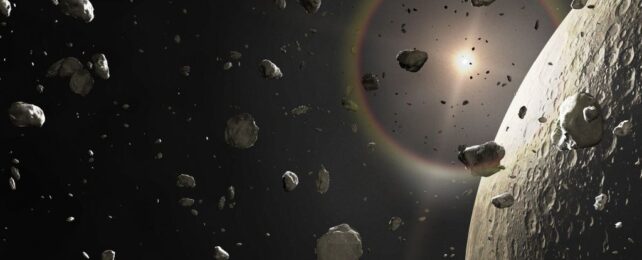There may be a lot more than we thought to the belt of icy debris that circles the outer Solar System.
Data from the New Horizons probe as it sails serenely through the Kuiper Belt hints at unexpected levels of particles where dust ought to be thinning out, suggesting the donut-shaped field extends significantly farther from the Sun than previous estimates suggest.
It's the most recent in a growing body of evidence that our understanding of the outer Solar System is lacking – but could help us better understand our planetary system, and others out there in the wider galaxy.
"New Horizons is making the first direct measurements of interplanetary dust far beyond Neptune and Pluto, so every observation could lead to a discovery," says physicist Alex Doner of the University of Colorado Boulder.
"The idea that we might have detected an extended Kuiper Belt – with a whole new population of objects colliding and producing more dust – offers another clue in solving the mysteries of the Solar System's most distant regions."
The Kuiper Belt is characterized by a high density of rocky, icy objects (icy because it's very far from the Sun, and very cold). It's filled with large rocks and dwarf planets, and a whole bunch of objects that we can't really see because they're relatively small, and it's very dark out there. But dust can tell us a fair bit about what's going on.
The Kuiper Belt was already thought to be pretty huge. It starts at the orbit of Neptune, some 30 astronomical units from the Sun, and extends outward for an unknown distance. However, the inner main region was thought to peter out at about 50 astronomical units.
New Horizons is the NASA probe launched to explore the outer Solar System. It visited Pluto, which orbits the Sun at an average distance of 39 astronomical units, in 2015, and kept going. In January 2019, it flew by a strange object named Arrokoth, which orbits the Sun at an average distance of 44.6 astronomical units.
Since then, between distances of 45 and 55 astronomical units, New Horizons kept collecting data, assiduously beaming it back home to Earth. And guess what? Its Venetia Burney Student Dust Counter (SDC) is detecting way more dust than scientists expected there to be at that distance.

A high density of dust means there needs to be either extra dust is being produced or solar radiative forces are unexpectedly pushing dust from denser regions out into that space.
The most likely source of any extra dust would be interactions between larger objects – collisions, for example. That means there needs to be enough icy rocks out there that they come together with relative frequency.
More recent telescope observations have started to suggest that the inner main region of the Kuiper Belt might extend as far as 80 astronomical units, meaning the discovery is consistent with hints that the Kuiper Belt just might be larger than expected.
At time of writing, New Horizons is more than 58 astronomical units from the Sun. It's now in its second extended mission, operating past initial expectations, and still sending data home. Scientists hope that it will last at least as far as 100 astronomical units, and perhaps, if we're lucky, as far as the very edge of the Solar System, beyond 120 astronomical units.
"These new scientific results from New Horizons may be the first time that any spacecraft has discovered a new population of bodies in our Solar System," says astronomer Alan Stern, New Horizons principal investigator of the Southwest Research Institute.
"I can't wait to see how much farther out these elevated Kuiper Belt dust levels go."
The amazing discovery has been published in The Astrophysical Journal Letters.
